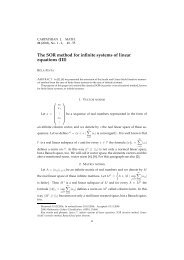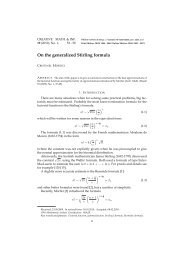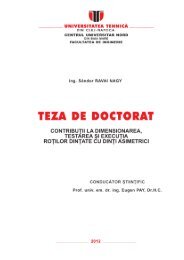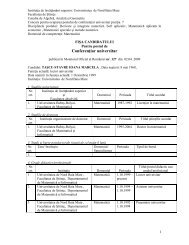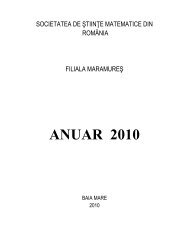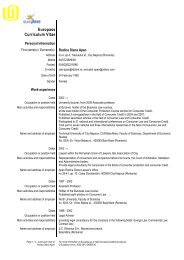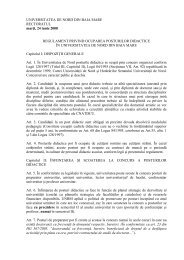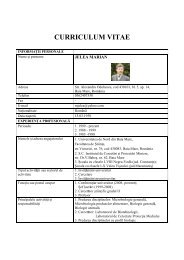Vol 3 (1) 2011 - UBM :: Departamentul de Chimie-Biologie
Vol 3 (1) 2011 - UBM :: Departamentul de Chimie-Biologie
Vol 3 (1) 2011 - UBM :: Departamentul de Chimie-Biologie
You also want an ePaper? Increase the reach of your titles
YUMPU automatically turns print PDFs into web optimized ePapers that Google loves.
Carpathian Journal of Food Science and Technology <strong>2011</strong>, 3(1), 1-6<br />
because of the abundant rains is obtained<br />
higher turbidity of the raw water. Practical<br />
trough the studied technological flux is<br />
whished an improving of the drinking water<br />
quality obtained in the treatment station in<br />
accordance with the legislation<br />
requirements.<br />
2. Materials and methods<br />
In the present paper was studied<br />
comparative the efficient use of aluminium<br />
sulphate and aluminium base poly chlorine<br />
in the coagulation process of the suspensions<br />
from water. In the view of optimum pH<br />
establish for the both coagulation reagent<br />
was used the calcium hydroxi<strong>de</strong>. The<br />
practical studies were ma<strong>de</strong> on the station<br />
“Micro plant” during the technological<br />
sample. The optimum coagulation dose for<br />
the both reagents were <strong>de</strong>terminate<br />
experimental in laboratory on water with<br />
different turbidity using the Jar-test method<br />
in the next conditions: 2 minutes of fast<br />
stirring (140 rot/min) and 15 minutes of slow<br />
stirring (40 rot/min) and 30 minutes of<br />
settling. Function of optimum coagulation<br />
doses obtained in laboratory for aluminium<br />
sulphate and aluminium base poly chlorine,<br />
was passed at their applying in the<br />
technological flux. Practical was studied a<br />
technical month of treatment using<br />
aluminium sulphate and calcium hydroxi<strong>de</strong><br />
and a technical month of treatment using<br />
aluminium base poly chlorine and calcium<br />
hydroxi<strong>de</strong>.<br />
The water turbidity was <strong>de</strong>terminate<br />
using a turbidity meter WTW 350 IR. The<br />
water pH was <strong>de</strong>terminate using a Hanna<br />
pH-meter. The water oxidability and<br />
hardness were <strong>de</strong>terminate using the<br />
volumetrically chemical methods. The<br />
residual aluminium, nitrates, nitrites were<br />
<strong>de</strong>terminate using an atomic absorption<br />
spectrophotometer Hach DR 2000. All the<br />
<strong>de</strong>termination methods of the parameters are<br />
in accordance with the legislation<br />
2<br />
requirements regarding the quality of<br />
drinking water.<br />
3. Results and discussions<br />
The technological flux of the station<br />
“Micro plant” contain the next stages:<br />
catching of the raw water, blending room,<br />
reaction room combined with lamellar<br />
clarifying tank, water filtration trough filters<br />
un<strong>de</strong>r pressure, water disinfection with<br />
sodium hypochlorite and drinking water<br />
storage.<br />
a) Characterisation of the water sources<br />
In Table 1 are presented the main<br />
parameters of the raw water in the studied<br />
period:<br />
Table 1. The parameters of the raw water<br />
No. Parameter Value<br />
crt.<br />
Minim Maxim<br />
1. Turbidity, 4,00 16,0<br />
NTU<br />
2. pH 6.70 6.80<br />
3. Alkalinity, 0.50 0.50<br />
mval/L<br />
4. Oxidability, 1.97 2.76<br />
mg/L O 2<br />
5. Hardness, D 1.68 1.79<br />
6. Aluminium, 0.008 0.028<br />
mg/L<br />
7. Nitrites, 0.000 0.009<br />
mg/L<br />
8. Nitrates,<br />
mg/L<br />
0.325 0.450<br />
b) The coagulation process efficiency using<br />
aluminium sulphate and calcium hydroxi<strong>de</strong><br />
In the frame of the ma<strong>de</strong> studies was<br />
followed the coagulation process efficiency<br />
using aluminium sulphate with calcium<br />
hydroxi<strong>de</strong>. This treatment technique<br />
correspond to an optimum pH = 7.0.<br />
In Figure 1 are presented the<br />
optimum doses of aluminium and calcium<br />
hydroxi<strong>de</strong> obtained experimental in



